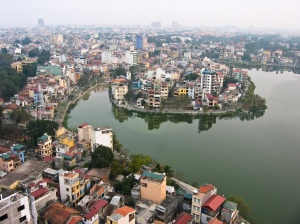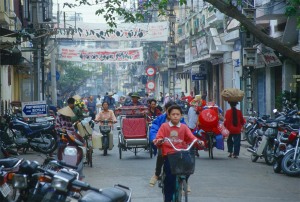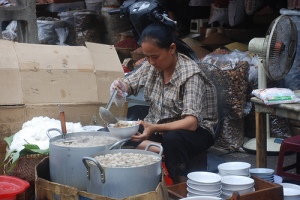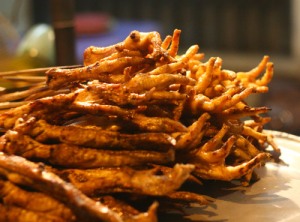I will spend today in and around Hanoi, visit some famous places and sample the culture and style of the city. Hanoi has always been the centre of Vietnam and was established in 1010. The city was the capital of the French Indochina between 1902 and 1954, when the French relinquished sovereignty to the Vietnamese. During the Vietnam war, it remained the capital of North Vietnam until the parts of teh embattled nation came back together in 1976. It’s a nice temperature today of about 26c, but very overcast and a touch humid. Still, nice to be walking around and taking the time for this fine city.
One fundamental thing I have learnt about the southern asia region is that life here goes back to an ancient age, and Hanoi is no exception. The red river area was inhabited from around 3000 BC, and has a strong trading and political base. This predates the Pyramids of Giza. In 1010, Ly Thai To, the first ruler of the Lý Dynasty, moved the capital of Đại Việt to the site of the Đại La Citadel. Claiming to have seen a dragon ascending the Red River, he renamed the site Thăng Long or Rising Dragon. In 1408, the Chinese Ming Dynasty walked in and took over. The invading China stuck around for twenty years and were driven out by the Vietnamese in 1428. It became Hanoi when the French took over in 1887.
As it is so close to the hotel I am staying in, my first call is to the Hoan Kiem Lake. There’s a touch of the Arthurian legend here, in that the lake was the home to the Golden Turtle God (Kim Qui), who handed the Emporer Lê Lợi a magical sword that empowered him to defeat the Chinese and drive them out. The lake is often referred to as the Sword lake, and soft-shell turtles live on the shallow island that stands in the centre. The rather impressive Turtle Tower was built in the 18th Century. The soft shell turtle is badly endangered, and no one seems to know how many are actually in the lake. The Old Quarter amounted to just 36 streets a hundred years ago, and each street had merchants that specialised in a particular trade. Now, the Old Quarter is surrounded by the modern city.
For lunch I decide to try one of the street stalls, which look a little less than safe, but the food look incredible. While simply asking for Chicken Street in Vietnamese – Phố Gà Nướng – will probably land you in the right place [If you can pronounce it!], the actual street name is Lý Văn Phúc. I can’t quite face the grilled chicken feet, so I go for the drumsticks instead. A great bowl of rice with a hot sauce makes the meal. There are some concerns about the general hygiene in these markets, and some of the restaurants for that matter, but with a little common sense it shouldn’t be too risky.
A little further on I pass Hỏa Lò Prison, otherwise known as the “Hanoi Hilton”. It was a prison used by the French colonists in Vietnam for political prisoners and later by North Vietnam for prisoners of war during the Vietnam War. I know it as the place that drug smugglers end up at after being caught at the airport.
As I head back to the Old Quarter and my hotel, I stop off at the Night Market. It is open late every Friday, Saturday and sundays. Dong Xuan Market was constructed by the French in 1889 and follows the many town markets you see in French towns and cities. It has to be said, it is mostly a tourist market selling souveniers, handicrafts, but I venture in and have a good look round.
It’s been a busy day and I have found some great places and easten dome terrific food. Tomorrow I head out towards China and another border crossing.




